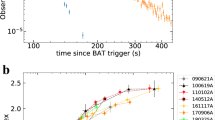Abstract
THE nature of γ-ray bursts remains one of the great mysteries of modern astronomy1,2. Although the spatial distribution of these high-energy sources is tightly constrained (they are distributed isotropically across the sky3), the same cannot be said of their spectral and temporal properties, for which few clear trends have been identified1,2. But it is from such properties that important clues about the physical mechanisms underlying the bursts are likely to be derived4,5. Here we show that for a sample of bursts consisting of well resolved, isolated energy pulses, and for which the spectra are sufficiently clean to allow their temporal evolution to be modelled, the photon energy at which the power output is maximum for each pulse decreases exponentially with photon fluence (that is, running time integral of photon flux). We find that for many multi-pulse bursts, the exponential decay constant is invariant from pulse to pulse. This property favours models in which the pulses arise from a regenerative source, rather than as a consequence of a single catastrophic event.
This is a preview of subscription content, access via your institution
Access options
Subscribe to this journal
Receive 51 print issues and online access
$199.00 per year
only $3.90 per issue
Buy this article
- Purchase on Springer Link
- Instant access to full article PDF
Prices may be subject to local taxes which are calculated during checkout
Similar content being viewed by others
References
Fishman, G. J. & Meegan, C. A. A. Rev. Astr. Astrophys. 33, 415–458 (1995).
Hurley, K. in Gamma Ray Bursts (eds Paciesas, W. & Fishman, G.) 3–12 (Conf. Proc. 265, Am. Inst. Phys. New York, 1992).
Meegan, C. A. et al. Astrophys. J. (submitted).
Schaefer, B. et al. Astrophys. J. 393, L51–L54 (1992).
Liang, E. in Gamma Ray Bursts (eds Paciesas, W. & Fishman, G.) 246–251 (Conf. Proc. 265, Am. Inst. Phys. New York, 1992).
Band, D. et al. Astrophys. J. 413, 281–292 (1993).
Ford, L. et al. Astrophys. J. 439, 307–321 (1995).
Norris, J. et al. Astrophys. J. 301, 213–219 (1986).
Ford, L., Band, D., Matteson, J., Teegarden, B. & Paciesas, W. in Gamma Ray Bursts (eds Fishman, G. et al.) 298–302 (Conf. Proc. 307, Am. Inst. Phys. New York, 1994).
Kargatis, V. et al. in Compton Gamma-Ray Observatory (eds Friedlander, M. et al.) 907–911 (Conf. Proc. 280, Am. Inst. Phys. New York, 1993).
Bhat, P. N. et al. in Compton Gamma-Ray Observatory (eds Friedlander, M. et al.) 912–916 (Conf. Proc. 280, Am. Inst. Phys. New York, 1993).
Rybicki, G. & Lightman, A. Radiative Processes in Astrophysics (Wiley, New York, 1979).
See Lamb D. Q. in Nuclear Spectroscopy of Astrophysical Source (eds Gehrels et al.) 265–284 (Conf. Proc. 170, AIP, 1987).
Harding, A. K. Phys. Rep. 206, 327–394 (1991).
Meszaros, P. & Rees, M. J. Astrophys. J. 405, 278–284 (1993).
Fenimore, E., in't Zand, J., Norris, J., Bonnell, J. & Nemiroff, R. Astrophys. J. (in the press).
Press, W., Teukolsky, S., Vetterling, W. & Flannery, B. Numerical Recipes 609–699 (Cambridge, UK, 1992).
Author information
Authors and Affiliations
Rights and permissions
About this article
Cite this article
Liang, E., Kargatis, V. Dependence of the spectral evolution of γ-ray bursts on their photon fluence. Nature 381, 49–51 (1996). https://doi.org/10.1038/381049a0
Received:
Accepted:
Issue Date:
DOI: https://doi.org/10.1038/381049a0
This article is cited by
-
On the connection of gamma-ray bursts and X-ray flashes in the BATSE and RHESSI databases
Astrophysics and Space Science (2016)
-
Comparison between the time-integrated spectrum and the peak time spectrum of gamma-ray bursts and possible implications
Science China Physics, Mechanics & Astronomy (2015)
-
The flux-E p relation within GRB060218 in comparison with typical GRB pulses
Science China Physics, Mechanics and Astronomy (2010)
-
Luminosity-peak energy relation in the decay phases of gamma-ray burst pulses
Science China Physics, Mechanics and Astronomy (2010)
-
A γ-ray burst with a high-energy spectral component inconsistent with the synchrotron shock model
Nature (2003)
Comments
By submitting a comment you agree to abide by our Terms and Community Guidelines. If you find something abusive or that does not comply with our terms or guidelines please flag it as inappropriate.



